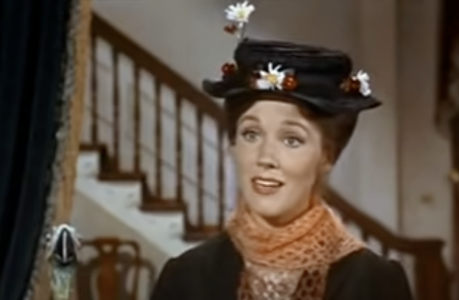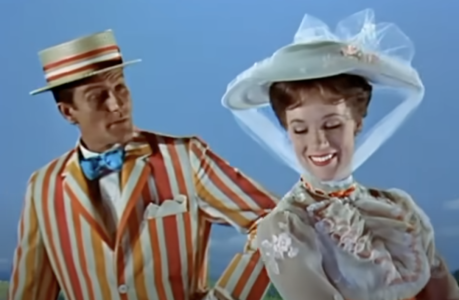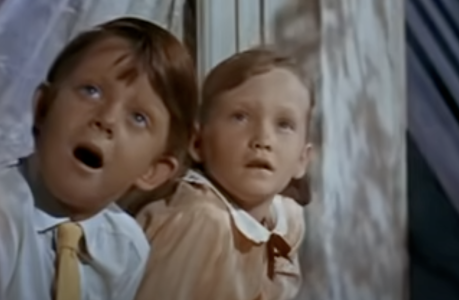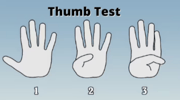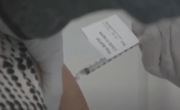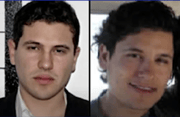21 Mary Poppins secrets that will completely change the way you see the movie
- Replies 0
If you thought you knew everything about Mary Poppins, think again!
This beloved classic, with its spoonfuls of sugar and magical carpet bags, is packed with behind-the-scenes stories, creative battles, and movie magic that will make you see it in a whole new light.
Whether you’re a lifelong fan or just discovering the Banks family’s adventures, these 21 secrets will have you humming Supercalifragilisticexpialidocious with fresh wonder—and maybe a little awe for the sheer determination and creativity that brought Mary Poppins to life.
1. Walt Disney’s 21-Year Pursuit of Mary Poppins
Walt Disney was nothing if not persistent. He first set his sights on adapting P.L. Travers’ Mary Poppins in 1938, just four years after the book’s debut. Travers, fiercely protective of her creation, rebuffed him for over two decades.
It wasn’t until 1959—after countless offers and a personal visit from Disney himself, complete with all the charm of a “friendly, charming uncle”—that Travers finally relented. But she didn’t go quietly: she demanded “final say” on the script, setting the stage for one of Hollywood’s most legendary creative tug-of-wars.
2. P.L. Travers: The Reluctant Consultant
Travers’ involvement didn’t end with signing the contract. She arrived at Disney Studios in 1961 and, according to those present, “didn’t like anything” about the adaptation.
She objected to Mary being impolite, and especially disliked the idea of the parents starting out cold and inattentive. Composer Richard Sherman argued that the parents’ transformation was the heart of the story.
Eventually, Travers signed off—reluctantly—and was credited as a consultant, though her battles with Disney would become the stuff of legend (and the inspiration for the film Saving Mr. Banks).
3. The Mary Poppins That Might Have Been
Before Julie Andrews floated in on her umbrella, the role of Mary Poppins was considered for stage and screen legends Mary Martin, Bette Davis, and Angela Lansbury.
Lansbury, in a delightful twist, would later appear in Mary Poppins Returns as the Balloon Lady, a sweet nod to what might have been.
4. Julie Andrews: From Camelot to Cherry Tree Lane
Julie Andrews caught Walt Disney’s eye after her performance in Camelot on Broadway.
Disney was so impressed, he flew to New York to see her in person, then acted out the entire Mary Poppins script backstage to convince her to take the role.
Andrews’ then-husband, Tony Walton, a talented costume and set designer, was also brought on board, making the film a family affair.
5. The My Fair Lady Snub That Made Movie History
Andrews was the obvious choice for My Fair Lady on film, having originated Eliza Doolittle on stage. But Hollywood opted for Audrey Hepburn, leaving Andrews free to take on Mary Poppins.
The rivalry played out during awards season, with Andrews famously thanking Jack Warner (who passed her over) in her Golden Globes acceptance speech after winning for Mary Poppins. The rest, as they say, is history.
6. Dick Van Dyke’s Double Duty (and Donation)
Dick Van Dyke was so eager to play the elderly Mr. Dawes Sr. (in addition to Bert) that he offered to do it for free.
Walt Disney agreed—on the condition that Van Dyke also donate $4,000 to the California Institute of the Arts. Van Dyke’s screen test was so convincing, even studio insiders were fooled.
7. The Infamous Cockney Accent
Van Dyke’s attempt at a Cockney accent has become the stuff of legend—mostly for how bad it was. He later joked that it was from “a little obscure county in the north of England.”
To this day, Brits still rib him about it, but honestly, would we have Bert any other way?
8. Hand-Painted London: The Magic of Matte Paintings
Artist Peter Ellenshaw created over 100 hand-painted matte backdrops for the film, including the iconic London skyline.
For the city at dusk, he poked tiny holes in the painting so real lights could shine through, making the city twinkle as if by magic.
9. Julie Andrews’ Nerve-Wracking First Scene
The very first scene filmed was Jolly Holiday—and it was also Andrews’ first time in front of a movie camera.
She was so nervous about her single line (“Do you really think so?”) that she fretted over how to deliver it. Her chemistry with Van Dyke, who could make her laugh with a single high kick, was instant.
10. 32 Songs, 14 in the Film
The Sherman brothers wrote a whopping 32 songs for Mary Poppins, but only 14 made the final cut.
Walt Disney’s favorite? Feed the Birds. Some unused melodies found new life in other Disney classics—The Land of Sand became Trust in Me in The Jungle Book.
11. The Secret of Mary’s Flying Costumes
To accommodate the flying harness, most of Mary’s costumes had to be made in duplicate, with extra room for the thick elastic body stocking and steel hip panels.
Julie Andrews spent so much time suspended in the air that she ended up with bruised hips—eventually padded with sheepskin for comfort.
12. Acting with Cardboard Penguins
Since the animated characters weren’t actually on set, actors used cardboard cutouts to establish their sightlines. Julie Andrews had to imagine penguins serving tea, while the merry-go-round horses were among the few props actually present.
13. Dancing with Invisible Penguins
Dick Van Dyke performed the Jolly Holiday dance solo, and animators later added the penguins, often having to “duck” or “jump” them out of the way of his flying feet.
Animator Frank Thomas, a Disney legend, led the charge, sometimes losing penguins to Van Dyke’s exuberant steps.
14. The Sodium Vapor Process: Movie Magic Before Green Screen
Instead of today’s green or blue screens, Mary Poppins used the sodium vapor process, filming actors against a white screen lit with yellow sodium lights.
This allowed animators to seamlessly insert colorful costumes and animated backgrounds, giving the film its vibrant, dreamlike look.
15. Six Weeks to Step In Time
The chimney sweep number Step In Time was so complex it required six weeks of rehearsal. Van Dyke, not a trained dancer, credited the grueling process with getting him in shape—and sparking a lifelong love of dance.
16. The Magic Carpet Bag: Real Reactions
The scene where Mary pulls impossibly large items from her carpet bag was filmed in two parts: Andrews on a soundstage, with crew members feeding items up through the bag, and the children reacting to an empty table. Their astonishment was genuine—they had no idea what would come out next!
17. Walking on Smoke: The Black Sponge Stairs
To create the illusion of walking up a staircase made of smoke, the crew built 'black sponge stairs' that gave way underfoot, making it look like the actors were sinking into clouds.
18. Floating Tea Parties: Set on a Tilt
For Uncle Albert’s floating tea party, the set was built to tilt 90 degrees, and actors were suspended on wires or perched on seesaws atop ladders. Walt Disney himself devised the technical wizardry to make the laughter-fueled levitation look real.
19. Practically Perfect Becomes Sister Suffragette
A song called Practically Perfect was originally meant to introduce Mary, but was cut. Its melody was repurposed for Sister Suffragette, Mrs. Banks’ rousing anthem.
Glynis Johns, who played Mrs. Banks, requested her own number—and got it, thanks to some quick work by the Sherman brothers.
Source: Jean Belmondo / Youtube.
20. The Lost Song: The Chimpanzoo
A whimsical number called The Chimpanzoo was fully developed and set to follow I Love to Laugh, but was scrapped at the last minute. Walt Disney felt the sequence was unnecessary, so the cast simply floated down after their tea.
21. Mary’s Secret Style: Hidden Costume Details
Costume designer Tony Walton added secret splashes of color to the linings of Mary’s prim outfits—vivid petticoats and playful linings that only showed when she danced or twirled.
Julie Andrews said this detail helped her understand Mary’s character: proper on the outside, a little mischievous on the inside.

Did any of these secrets surprise you? Do you have a favorite Mary Poppins moment, or a behind-the-scenes tidbit we missed? Maybe you remember seeing it in theaters, or sharing it with your grandkids for the first time. We’d love to hear your stories and memories—share them in the comments below!
This beloved classic, with its spoonfuls of sugar and magical carpet bags, is packed with behind-the-scenes stories, creative battles, and movie magic that will make you see it in a whole new light.
Whether you’re a lifelong fan or just discovering the Banks family’s adventures, these 21 secrets will have you humming Supercalifragilisticexpialidocious with fresh wonder—and maybe a little awe for the sheer determination and creativity that brought Mary Poppins to life.
1. Walt Disney’s 21-Year Pursuit of Mary Poppins
Walt Disney was nothing if not persistent. He first set his sights on adapting P.L. Travers’ Mary Poppins in 1938, just four years after the book’s debut. Travers, fiercely protective of her creation, rebuffed him for over two decades.
It wasn’t until 1959—after countless offers and a personal visit from Disney himself, complete with all the charm of a “friendly, charming uncle”—that Travers finally relented. But she didn’t go quietly: she demanded “final say” on the script, setting the stage for one of Hollywood’s most legendary creative tug-of-wars.
2. P.L. Travers: The Reluctant Consultant
Travers’ involvement didn’t end with signing the contract. She arrived at Disney Studios in 1961 and, according to those present, “didn’t like anything” about the adaptation.
She objected to Mary being impolite, and especially disliked the idea of the parents starting out cold and inattentive. Composer Richard Sherman argued that the parents’ transformation was the heart of the story.
Eventually, Travers signed off—reluctantly—and was credited as a consultant, though her battles with Disney would become the stuff of legend (and the inspiration for the film Saving Mr. Banks).
3. The Mary Poppins That Might Have Been
Before Julie Andrews floated in on her umbrella, the role of Mary Poppins was considered for stage and screen legends Mary Martin, Bette Davis, and Angela Lansbury.
Lansbury, in a delightful twist, would later appear in Mary Poppins Returns as the Balloon Lady, a sweet nod to what might have been.
4. Julie Andrews: From Camelot to Cherry Tree Lane
Julie Andrews caught Walt Disney’s eye after her performance in Camelot on Broadway.
Disney was so impressed, he flew to New York to see her in person, then acted out the entire Mary Poppins script backstage to convince her to take the role.
Andrews’ then-husband, Tony Walton, a talented costume and set designer, was also brought on board, making the film a family affair.
5. The My Fair Lady Snub That Made Movie History
Andrews was the obvious choice for My Fair Lady on film, having originated Eliza Doolittle on stage. But Hollywood opted for Audrey Hepburn, leaving Andrews free to take on Mary Poppins.
The rivalry played out during awards season, with Andrews famously thanking Jack Warner (who passed her over) in her Golden Globes acceptance speech after winning for Mary Poppins. The rest, as they say, is history.
6. Dick Van Dyke’s Double Duty (and Donation)
Dick Van Dyke was so eager to play the elderly Mr. Dawes Sr. (in addition to Bert) that he offered to do it for free.
Walt Disney agreed—on the condition that Van Dyke also donate $4,000 to the California Institute of the Arts. Van Dyke’s screen test was so convincing, even studio insiders were fooled.
7. The Infamous Cockney Accent
Van Dyke’s attempt at a Cockney accent has become the stuff of legend—mostly for how bad it was. He later joked that it was from “a little obscure county in the north of England.”
To this day, Brits still rib him about it, but honestly, would we have Bert any other way?
8. Hand-Painted London: The Magic of Matte Paintings
Artist Peter Ellenshaw created over 100 hand-painted matte backdrops for the film, including the iconic London skyline.
For the city at dusk, he poked tiny holes in the painting so real lights could shine through, making the city twinkle as if by magic.
9. Julie Andrews’ Nerve-Wracking First Scene
The very first scene filmed was Jolly Holiday—and it was also Andrews’ first time in front of a movie camera.
She was so nervous about her single line (“Do you really think so?”) that she fretted over how to deliver it. Her chemistry with Van Dyke, who could make her laugh with a single high kick, was instant.
10. 32 Songs, 14 in the Film
The Sherman brothers wrote a whopping 32 songs for Mary Poppins, but only 14 made the final cut.
Walt Disney’s favorite? Feed the Birds. Some unused melodies found new life in other Disney classics—The Land of Sand became Trust in Me in The Jungle Book.
11. The Secret of Mary’s Flying Costumes
To accommodate the flying harness, most of Mary’s costumes had to be made in duplicate, with extra room for the thick elastic body stocking and steel hip panels.
Julie Andrews spent so much time suspended in the air that she ended up with bruised hips—eventually padded with sheepskin for comfort.
12. Acting with Cardboard Penguins
Since the animated characters weren’t actually on set, actors used cardboard cutouts to establish their sightlines. Julie Andrews had to imagine penguins serving tea, while the merry-go-round horses were among the few props actually present.
13. Dancing with Invisible Penguins
Dick Van Dyke performed the Jolly Holiday dance solo, and animators later added the penguins, often having to “duck” or “jump” them out of the way of his flying feet.
Animator Frank Thomas, a Disney legend, led the charge, sometimes losing penguins to Van Dyke’s exuberant steps.
14. The Sodium Vapor Process: Movie Magic Before Green Screen
Instead of today’s green or blue screens, Mary Poppins used the sodium vapor process, filming actors against a white screen lit with yellow sodium lights.
This allowed animators to seamlessly insert colorful costumes and animated backgrounds, giving the film its vibrant, dreamlike look.
15. Six Weeks to Step In Time
The chimney sweep number Step In Time was so complex it required six weeks of rehearsal. Van Dyke, not a trained dancer, credited the grueling process with getting him in shape—and sparking a lifelong love of dance.
16. The Magic Carpet Bag: Real Reactions
The scene where Mary pulls impossibly large items from her carpet bag was filmed in two parts: Andrews on a soundstage, with crew members feeding items up through the bag, and the children reacting to an empty table. Their astonishment was genuine—they had no idea what would come out next!
17. Walking on Smoke: The Black Sponge Stairs
To create the illusion of walking up a staircase made of smoke, the crew built 'black sponge stairs' that gave way underfoot, making it look like the actors were sinking into clouds.
18. Floating Tea Parties: Set on a Tilt
For Uncle Albert’s floating tea party, the set was built to tilt 90 degrees, and actors were suspended on wires or perched on seesaws atop ladders. Walt Disney himself devised the technical wizardry to make the laughter-fueled levitation look real.
19. Practically Perfect Becomes Sister Suffragette
A song called Practically Perfect was originally meant to introduce Mary, but was cut. Its melody was repurposed for Sister Suffragette, Mrs. Banks’ rousing anthem.
Glynis Johns, who played Mrs. Banks, requested her own number—and got it, thanks to some quick work by the Sherman brothers.
Source: Jean Belmondo / Youtube.
20. The Lost Song: The Chimpanzoo
A whimsical number called The Chimpanzoo was fully developed and set to follow I Love to Laugh, but was scrapped at the last minute. Walt Disney felt the sequence was unnecessary, so the cast simply floated down after their tea.
21. Mary’s Secret Style: Hidden Costume Details
Costume designer Tony Walton added secret splashes of color to the linings of Mary’s prim outfits—vivid petticoats and playful linings that only showed when she danced or twirled.
Julie Andrews said this detail helped her understand Mary’s character: proper on the outside, a little mischievous on the inside.
Key Takeaways
- Walt Disney spent over 20 years trying to obtain the rights to adapt Mary Poppins, finally succeeding when P.L. Travers agreed in 1959, but only after being promised final say on the script.
- Julie Andrews landed the role of Mary Poppins after Disney saw her perform in Camelot, but she was almost cast as Eliza Doolittle in My Fair Lady before losing the film role to Audrey Hepburn.
- The film featured innovative special effects for its time, including hand-painted matte backdrops, the sodium vapor process for blending live action and animation, and custom costumes to accommodate flying harnesses for Julie Andrews.
- Several songs and scenes were written and even filmed or developed but ultimately cut from the final film, and costume designer Tony Walton hid colorful linings in Mary’s costumes to hint at the character’s playful, secret side.
Did any of these secrets surprise you? Do you have a favorite Mary Poppins moment, or a behind-the-scenes tidbit we missed? Maybe you remember seeing it in theaters, or sharing it with your grandkids for the first time. We’d love to hear your stories and memories—share them in the comments below!

